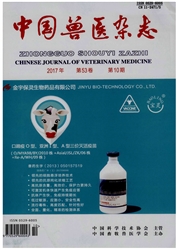

 中文摘要:
中文摘要:
试验分离培养了兔乳房炎病原菌,观察了兔乳房炎组织的病理学变化,并研究了病原菌对抗生素和小檗碱的敏感性及其形态学变化.结果发现,受感染的乳房组织出现炎性细胞浸润,腺泡上皮细胞坏死、脱落,腺泡结构改变,间质纤维增生等;兔乳房炎的致病菌主要是金黄色葡萄球菌、停乳链球菌和大肠杆菌,敏感的抗生素有恩诺沙星、头孢曲松和红霉索等;扫描电镜下观察到小檗碱使金黄色葡萄球菌和停乳链球菌菌体表面变粗糙,出现很多凸起物,大肠杆菌表面有一处或多处凹陷,菌体皱缩弯曲.上述结果说明,兔乳房炎的病原菌主要是常在菌,小檗碱对其有明显的抑菌效果,且对球菌和杆菌的抑菌机制可能不同.
 英文摘要:
英文摘要:
The pathogens of rabbit mastitis were deler,nined and the histopathological changes of the infected mammary gland tissues we,'e examined in this study. The sensitivity of the pathogens to both antibiotics and berberine were tested. The morphological changes of lhe pathogens treated with berberine were monitored using scanning electron microscopy. The resuhs showed that the infected mammary gland lissues were infiltrated with inflammatory cells,anti acinar epithelial cell necrosis and fel! off and interstitid tissue hyperplasia were observrd.ln addition, acinar cavity was narrowed and its structure was changed.The main pathogenic bacteria were S.aureus, S.dysgalactiae equisimilis and E.coli, which were all sensitive to enrofloxacin, eeftriaxone and erythromycin;Some bulge appeared on both the surfaces of S.aureus and S.dysgalactiae equisimilis treated with berberine observed using scanning electron microscope. On the other hand, the E. colt had surface indentations and the cells shriveled. The above results indicate that the pathogens of rabbit mastitis are mainly environmental bacteria and sensitive to berberine. Bacteriostatic action of berberine may be different for coccus and bacillus.
 同期刊论文项目
同期刊论文项目
 同项目期刊论文
同项目期刊论文
 Saikosaponin-D Attenuates Heat Stress-Induced Oxidative Damage in LLC-PK1 Cells by Increasing the Ex
Saikosaponin-D Attenuates Heat Stress-Induced Oxidative Damage in LLC-PK1 Cells by Increasing the Ex 期刊信息
期刊信息
